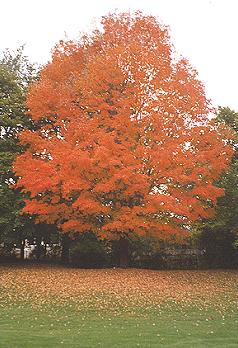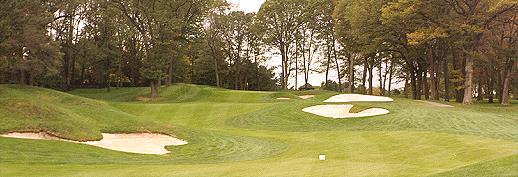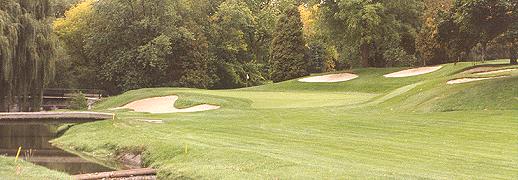St. George’s Golf & Country Club
Ontario, Canada
 Only in Canada
|
On one side of a busy thoroughfare is the St. George’s course. This side is a dry county. On the other side, a clubhouse, this time located in a county that is not dry. Right away, you know this is a smart club and that wisdom manifested itself in whom they hired to design their course.
Stanley Thompson was coming off great success at Jasper Park and Banff Springs. Upon Banff’s opening in 1929, it was widely acknowledged among the world’s best. Canadian Pacific Railway, who had footed the bill for what was then most expensive course ever built, was delighted with Thompson and hired him again to design St. George’s (known at the time as the Royal York Golf Club). It was a perfect match from the start: an architect at the height of his powers was given a scintillating piece of property with the perfect amount of roll for a golf course.
Stanley Thompson used the valleys and ridges that dominant to full advantage – no mean feat given that if he made a misstep, the course could end up fighting the terrain. As it is (and as usual), Thompson got it right and one of the tricks to the course is placing the ball to avoid the sidehill, downhill and uphill lies. How to do this most efficiently won’t be evident on your first few rounds, but what great course doesn’t take (and deserve) time to get to know her?
In 1967, St. George’s hired Robbie Robinson, who had worked and studied under Thompson, to prepare the course for the 1968 Canadian Open. Among other things, he relocated the greens on the par five 4th and 15th holes to their present majestic locations. Though these two greens seem disproportionately big compared to Thompson’s original ones, they are full of character and their location on top of hills makes those two holes.
The authors toyed around with doing A Holes Not to Note section for St. George’s, as that would be far shorter. Not one hole is over indifferent land and with the exception of the 9th, not one green lacks appeal. Still, we have confined it to the holes below.
Holes to Note:
Second hole, 450 yards; This hole symbolizes the appeal of the two shot holes at St. George’s. There is plenty of room off the tee, even though the artistic fairway bunker on the left is near the ideal spot that opens up the long, narrow green. The green complex has four uniquely shaped bunkers, the type that only Thompson built and that characterize his courses. Finally, the green itself has a knoll front right and back left, creating numerous hole locations. The green is not overtly dramatic, but my word, it is full of interest.

The twisting fairway that leads to the 4th green.
Fourth hole, 475 yards; Another in a long line of examples here of ingeniously routing a hole through a valley. A big drive brings the green into reach. However, anything less than ideal and the second shot must slot in between a fairway bunker on the left and two more further down on the right. Once past the 150-yard mark, the hillside on either side of the snaking fairway is covered in tall, unkempt grass, giving this hole some teeth should the golfer stray.
Fifth hole, 430 yards; The downhill drive is to a wickedly contoured fairway. Ideally the hump in the left side will kick the tee ball down into the flat, right part of the fairway. From there, the golfer has a better view of the green and will be hitting from a level stance. The green is not terribly wide at just 18 paces and there is a sharp drop off to the right.
Seventh hole, 440 yards; A beautifully bunkered hole with a bunker jutting in from the right at the 220 yard mark and two further up on the left at the 300 mark. The green rises 24 feet from the 150 yard mark, so always take at least one extra club. This rise also signifies that the green is on top of a knoll and any putt from above is a terror.
Twelfth hole, 380 yards; The green is placed on a ledge and anything short rolls well back down the fairway. Of course, anything long and the golfer faces a nasty putt down the slick slope of the green. The approach is one of the most exacting on the course, as befits a hole of this length.

The well defended 14th green with the stream on the left.
Fourteeth hole, 445 yards; The ideal use of a stream, this one appears on the right hand side of the fairway and travels up the length of the hole before cutting in front of the green. The down slope in the fairway starts two hundreds from the green: some players opt to lay up to this point for the sake of a flat lie and others hope to get as much run down the slope as possible to shorten their second. Though six bunkers frame the green, it is the stream that gets everyone’s attention. The green mercifully offers some of the straighter putts on the course.
Fifteenth hole, yards; A vast hole that twists through its own valley before being capped off by a green perched some 40 feet above the 150 yard marker. The fairway bunkering cut into the sides of the valley show the way and serve to accentuate the holes beauty. This hole is but another example of Thompson’s mastery of fairway bunkering.

Heading up the difficult 18th, with the clubhouse in the background.
Final three holes; The finish enjoys the reputation as being amongst the finest in Canada and beyond. The 16th is a 200 yard par three up a hill some 16 feet but most first time visitors are deceived into thinking the shot is over level terrain. The ensuing chip and putt is rarely successful. The next bogey comes at the 17th, a stout two-shotter of 470 yards to a 15 yard wide green (yikes!) that juts onto a peninsula with deep grassy valleys on each side. The finally hole parallels the 17th and heads directly back toward the imposing English style clubhouse. Again, the green is almost 40 feet above the tee so the hole plays the full measure of 450 yards.
After the 18th green, you have a clear view down the valley of the lovely first hole. The appeal and pull of the course is such that many golfers go back out for a few more holes. This feature of enjoyment separates St. George’s Golf & Country Club from the modern, big budget pretenders around Toronto that just wear you out. Stanley Thompson would smile, content in knowing St. George’s has more than stood the test of time.
The End

